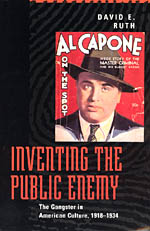Inventing the Public Enemy

Humboldt Park native Michael Mann’s new film Public Enemies, which portrays the life and death of one of the Chicago’s most notorious criminals, John Dillinger, premiers in theaters this weekend. And in all likelihood, similar to last year’s summer blockbuster Batman, you can be sure that thousands of Chicagoans, eager to see their city—or at least bits and pieces of their city—up on the big screen will be packing the theaters.
In light of such predictable crowds most reasonable people will choose to pass on Public Enemies in favor of some more edifying cultural experience this Fourth of July weekend. But, as David E. Ruth’s Inventing the Public Enemy: The Gangster in American Culture, 1918-1934 demonstrates, with the right frame of mind—and the right book—Public Enemies might be as edifying as it gets. In Inventing the Public Enemy Ruth scrutinizes innumerable newspaper and magazine articles, scores of novels, and hundreds of Hollywood movies, to show how the media’s “gangsters” are less a reflection of reality than a projection created from Americans’ values, concerns, and ideas about what sells.
Ruth takes us through a media landscape filled with efficient criminal executives demonstrating the multifarious uses of organization; dapper, big-spending gangsters highlighting the promises and perils of an emerging consumer society; and gunmen and molls guiding an uncertain public through the shifting terrain of modern gender roles. In this fascinating study, Ruth reveals how the public enemy provides a far-ranging and insightful critique of modern culture.
Read more about the book here.